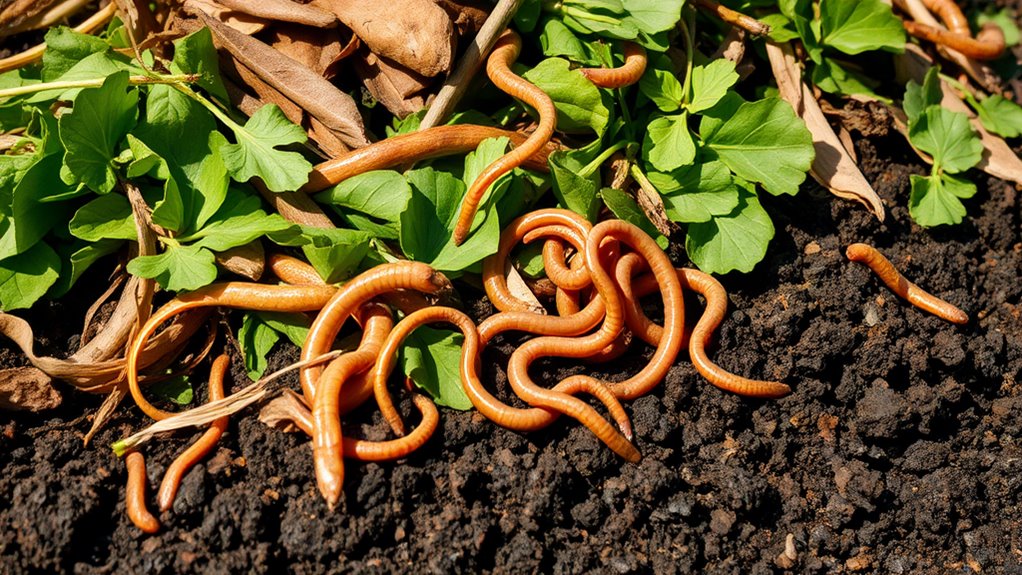I Didn’t Believe This Compost Recipe Until I Tried It
You’ve likely doubted this compost recipe, but once you try it, you’ll see kitchen scraps turn into nutrient-rich soil faster than expected. Mix greens like vegetable peels with browns like shredded leaves for balance, then layer and turn your pile regularly to boost decomposition. It boosts garden health and cuts waste effortlessly. Discover more ways to make your composting journey even simpler from here.
The Skeptical Beginner’s Journey
Have you ever wondered if composting is really worth the hassle? You’re about to uncover composting secrets that make it surprisingly simple for skeptical beginners.
Doubt its value all you want, but these practical tips let you transform kitchen scraps into nutrient-rich soil efficiently. Effective composting techniques can help you maximize your composting efforts and ensure a successful outcome.
It’s an authoritative way to boost your garden, cut waste, and reap rewards without the mess. Start today and conquer your reservations.
Key Ingredients for This Compost Magic
Now that you’ve conquered your doubts about composting, gather these key ingredients to create nutrient-rich soil effortlessly.
These essentials balance your pile for ideal results.
- Fresh greens like vegetable scraps and grass clippings, supplying essential nitrogen to spark decomposition and enrich the mix.
- Dry browns such as leaves and shredded paper, providing carbon for structure and airflow to prevent clumping.
- Water and compost starters, maintaining moisture and introducing microbes for efficient, natural breakdown. Additionally, incorporating composting benefits can enhance your gardening experience and promote sustainable practices.
Simple Steps to Build Your Pile
With your key ingredients in hand, build your compost pile by starting with a thick layer of browns for aeration, then alternating greens and more browns to maintain balance and speed up decomposition.
Next, add water to keep it moist but not soggy; this aids in breakdown.
Turn the pile every few weeks to introduce oxygen and prevent odors.
Aim for a pile that’s at least 3 feet wide for efficient heating. Additionally, maintaining a balanced ratio of greens and browns is crucial for successful composting.
Unexpected Transformations in Action
As your compost pile matures, you’ll witness remarkable transformations where kitchen scraps and yard waste morph into nutrient-rich soil, often faster than expected. This process showcases nature’s efficiency through visible changes.
- Fruit peels vanish overnight, seamlessly integrating into the soil base.
- Grass clippings transform from green masses to fine particles.
- Leaves curl and crumble, enriching the compost with organic matter.
Additionally, implementing smart composting practices can significantly speed up this decomposition process, resulting in richer soil.
Surprising Benefits for Your Garden
Beyond its transformative magic, you’ll discover that composting delivers surprising benefits to your garden, from boosting soil fertility and deterring pests naturally to promoting robust plant growth with minimal effort.
This enriched soil enhances nutrient uptake, making your plants thrive and reducing the need for chemical fertilizers.
Beneficial microbes effectively deter pests, fostering a healthier ecosystem with less intervention from you. Additionally, avoiding common composting mistakes ensures that your compost is rich and effective, maximizing its benefits for your garden.
Pro Tips for Long-Term Success
You’ll master aeration techniques and layering methods to keep your compost thriving over the long haul.
These strategies guarantee you maintain ideal airflow and structure, preventing common pitfalls like compaction.
Implement them now for a robust, productive pile that supports your garden’s health.
Aeration Techniques
Aeration keeps your compost pile thriving by introducing oxygen, which speeds up decomposition and prevents foul odors.
As an expert, you’ll need to turn the pile regularly to maintain balance and avoid compaction.
- Use a pitchfork to flip materials thoroughly every few days for even oxygen distribution.
- Add bulky items like straw to create air pockets and enhance airflow.
- Monitor the pile’s temperature; a steady warmth signals effective aeration and healthy microbial activity.
Layering Methods
Layering your compost pile builds a balanced structure that promotes even decomposition and sustains long-term health.
Start with a thick brown layer for drainage, then add greens for nitrogen; alternate layers to maintain a 3:1 brown-to-green ratio.
You’ll turn the pile weekly to aerate, keeping it moist but not soggy.
This prevents odors and speeds breakdown, yielding rich soil amendment for your garden.

